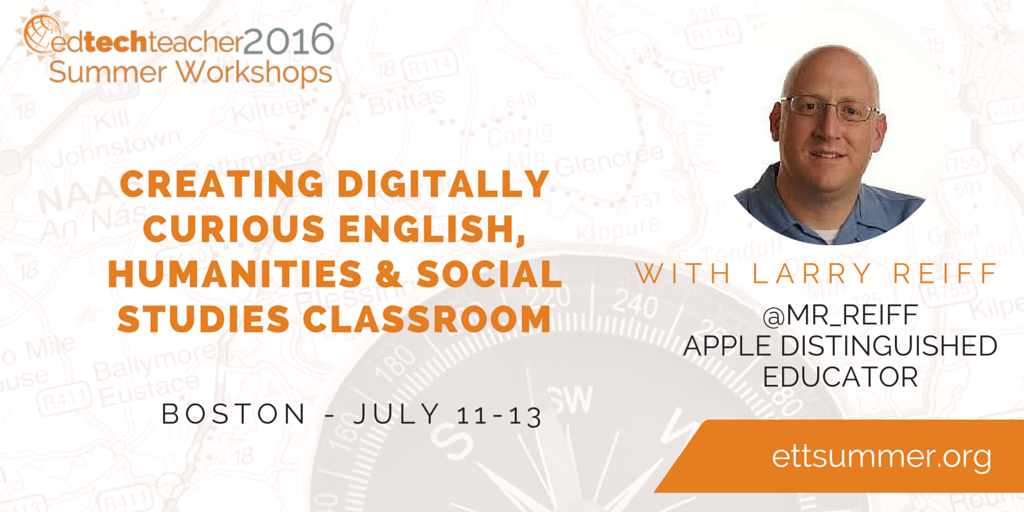Larry, a humanities teacher at Roslyn High School, is in the 5th year of his 1:1 iPad program and an Apple Distinguished Educator. While his technology has been beneficial, he finds that his work in the Folger Teaching Shakespeare Institute to have been the most valuable experience for making Shakespeare and literature more meaningful for high school students.
Most people do not have pleasurable memories of doing Shakespeare. However, he is even in the Common Core. Given the fact that today's students come from the digital native generation, they need to experience Shakespeare in a more interactive way. Students need ways to interact with the text in ways that were unimaginable from when most teachers were students in schools. The Folger Method teaches that students should interact with the text of Shakespeare - more than just reading out loud - but getting hands dirty with the text. iOS devices allow students to connect with the text in a risk-free way and in a manner that they find more comfortable.
"Shakespeare Apps"
There are two types of apps to be used in conjunction with literature. There are text replacement apps that allow you to interact with the text, and there are expression apps that allow students to demonstrate their understanding. Larry does not like translation apps as he feels that those essentially say to students, "you are too stupid to understand this text." However, No Fear Shakespeare or Shakespeare in Bits are good options as they allow for interaction.
Shakespeare and SAMR
Larry likes to view all apps and activities through the SAMR model A text replacement app is at the Substitution level. The next step may be to Augment instruction and experience through video analysis of different Shakespearean intent so that students can understand both directorial intent and ultimately authorial intent. He uses creation apps such as Comic Life to have students interact in new ways. Another app that he uses a lot is Voice Recorder. How can stressing different words imply meaning? The use of inflection can change the meaning.
What would the Facebook profiles of Romeo and Juliet look like? Larry uses modern conventions to allow students to make deeper connections to characters. How would their status change throughout the course of the play? Think about it with Macbeth. How does his employment status change? If Juliet had no one on her friends list beyond the nurse, what does that mean for her life as a 13-year-old during that time?
Twitter in the classroom allowed Larry to get his students to drill down to the core meaning of speech or soliloquy. Imagine what happens when students can boil down the text to 140 characters or less. One of the challenges is that students do not like to act out in front of their classrooms. However, if they can go home and act via their device and use friends and family as actors through apps such as Puppet Pals.
Another technique that Larry uses to get his students to engage with the text is digital storytelling. He shows examples of when students used apps such as Tellagami and iMovie to create animated versions of soliloquies. His goal is for the "words to come out of his students' mouths." He wants them to engage with the text. Larry only has one rule, "no posters." He will accept any proposal that includes evidence from the text and deep inquiry. One example includes a Stop Motion retelling of Julius Cesar where the students even helped to write the rubric for the assignment. What was wonderful about the experience was that the student ended up far exceeding Larry's expectations for the project. Larry wants the students to choose options that allow them to think deeply but that also align with their passions.
Larry likes students to compare why directors make the decisions that they do as a way to scaffold the concept of understanding authorial intent. To do this, he uses Green Screen to have students give commentary on the scenes that they watch and talk both about the director's decisions as well as what they think Shakespeare may think of the reproduction of the play.
Lately, Larry has had his students annotate text with ThingLink by adding image and text to further explain the text. These annotations could include vocabulary definitions, illustrations of concepts, analysis of lines, and to demonstrate their understanding of the lines of text.
Last year, Larry started using the "Cut Away" as a way for students to explain their thinking. First, they film themselves performing a scene. Then, they pull out and do some cutaway clips. This provides students with an opportunity to express their opinions and engage with their language. Similarly, what if Romeo and Juliet took place in the Real World rather than in Verona. When students have an opportunity to have fun with the language, they enjoy learning about Shakespeare and literature. If they can enjoy it as early students, then it will reshape the way that they think about Shakespeare. Larry wants his students to develop a passion for learning. His only requirement is to show textual evidence. As a final example, Larry shares a rap that one of his students created to show his understanding of Romeo & Juliet.


